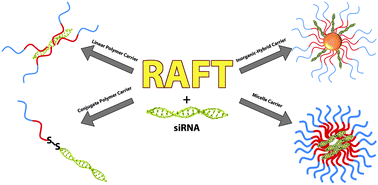The advent of controlled radical polymerization (CRP) techniques, along with advancements in facile conjugation chemistry, now allow synthetic tailoring of precise, polymeric architectures necessary for drug/gene delivery. Reversible addition–fragmentation chain transfer (RAFT) polymerization and its aqueous counterpart (aRAFT) afford quantitative control over key synthetic parameters including block length, microstructure, and placement of structo-pendent and structo-terminal functionality for conjugation of active agents and targeting moieties. The relevance of water-soluble and amphiphilic (co)polymers synthesized by RAFT for in vivo delivery of therapeutics in biological fluids is an especially attractive feature. In many cases, polymerization, binding, conjugation, and stimulus-induced release can be accomplished directly in aqueous media. This review focuses on RAFT synthesized (co)polymers as vectors for delivery of small interfering ribonucleic acid (siRNA) and gene down-regulation via the RNA interference (RNAi) pathway. Synthetic strategies utilizing RAFT and facile side- and end-chain reaction chemistries to afford modular delivery architectures (linear, stars/hyperbranched, micelles, and hybrid (co)polymeric vehicles) are reviewed based on examples from current literature. Also, specific problems, barriers, and challenges regarding rational design of polymeric delivery systems for therapeutic siRNA are presented.
